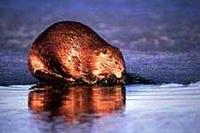Beaver
BEAVER (Castor canadensis) is a large brown mammal of the order Rodentia (RODENTS) weighing up to 35 kg and inhabiting forested areas across the province, including VANCOUVER ISLAND and introduced to the QUEEN CHARLOTTE ISLANDS. Beavers spend much of their time in the water; their broad black tails are scaly and paddle-shaped, their large hind feet are webbed for swimming and their red-brown fur is insulated for warmth. Beaver fur has 2 surfaces: an outer layer of long, coarse "guard" hair and an under layer of fine, smooth "wool." FIRST NATIONS used the pelts for clothing, but it was the underfur that Europeans used to make felt hats, making the animal valuable to the FUR TRADE. Beavers live in LAKES and streams (see RIVERS), where they build their lodges out of logs, branches and mud. Though the opening to the lodge is built beneath the water, the inside remains dry and warm. The pile is hollowed (or gnawed) out above the high-water mark so that the animals can live inside. They also build dams to maintain the water level around their lodges. Beavers have large front teeth for gnawing on wood and collecting the material they need for their elaborate constructions. They have a varied diet of leaves and bark of aspen, willows, roots and stems of pond lilies and other pond weeds, cattails and some sedges. Beavers mate for life and the female gives birth to 3–4 young in the spring. Two-year-olds leave the colony in midsummer and pair up to build new lodges. They may travel widely during this period. Although beavers are preyed upon by all large carnivores, their most serious enemy is disease, notably tularemia. Along with their historical economic importance, beavers play a crucial role in maintaining their forest aquatic ecosystem.

